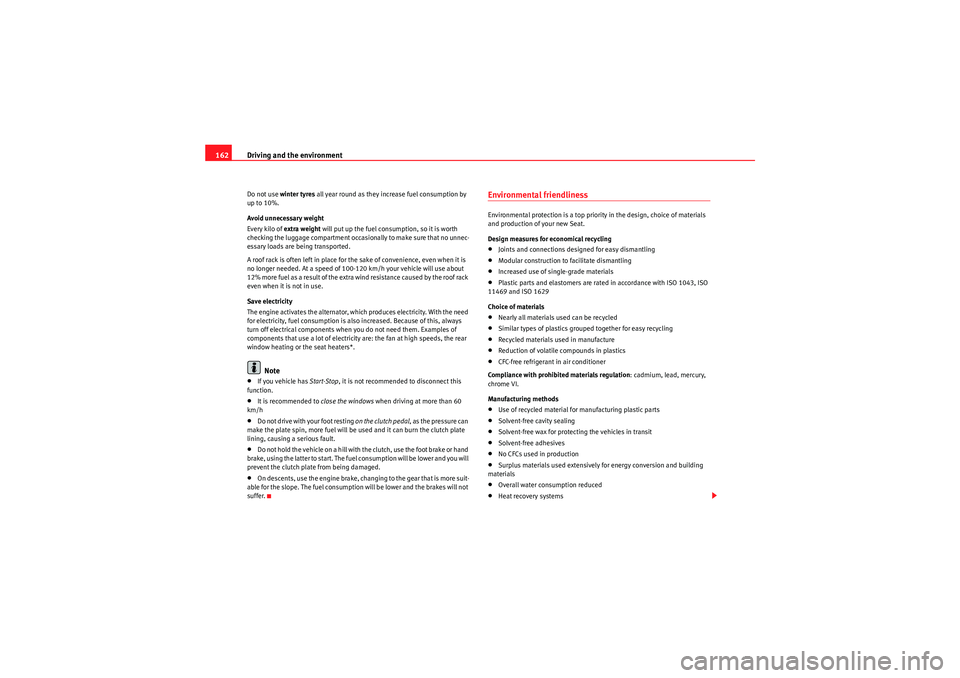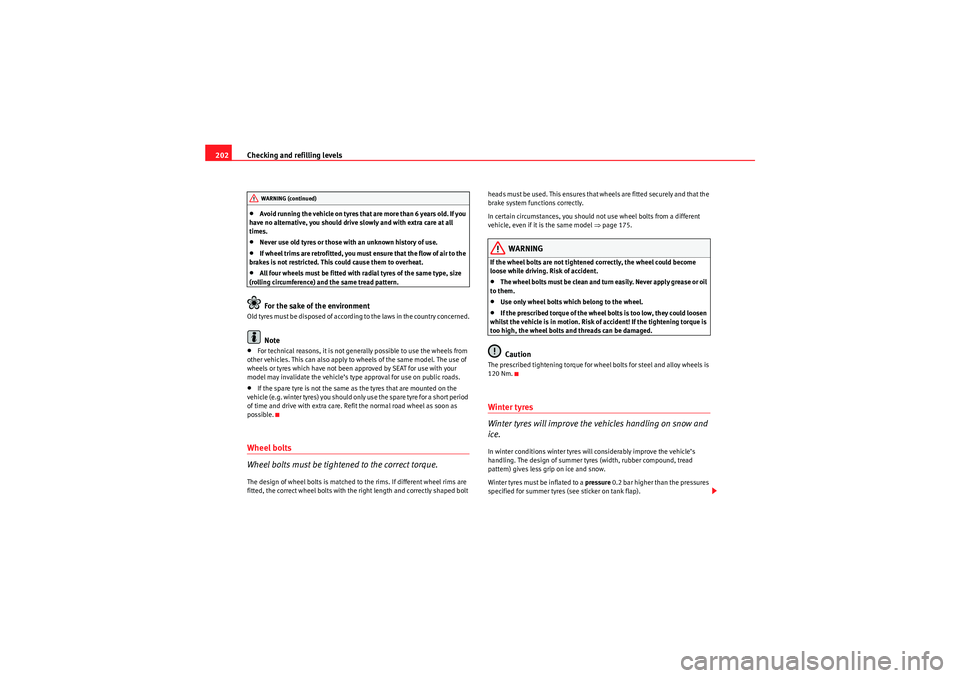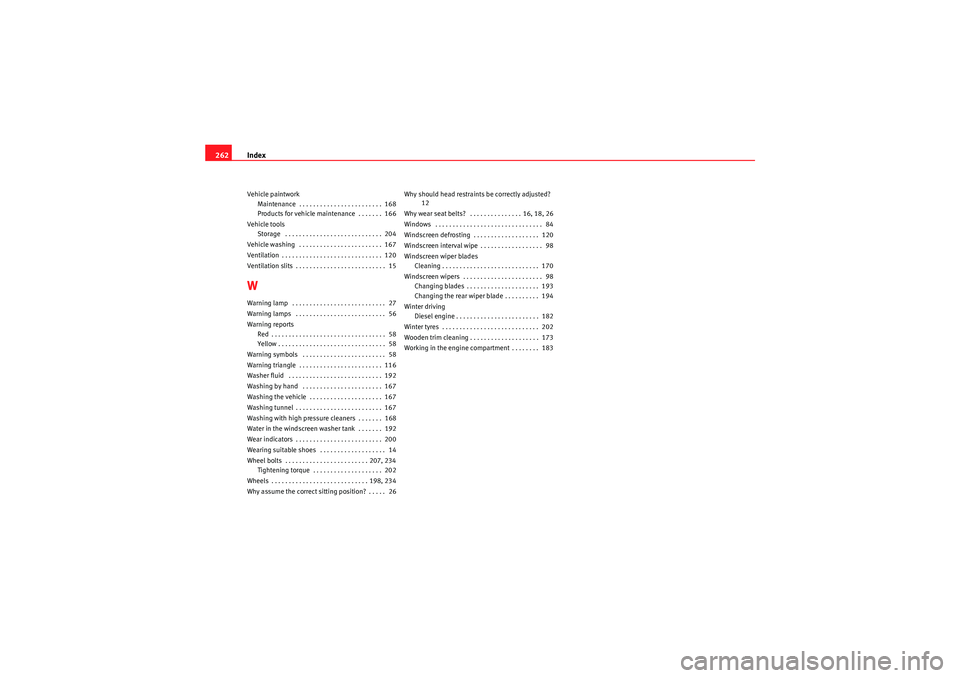2010 Seat Ibiza 5D winter tyres
[x] Cancel search: winter tyresPage 164 of 266

Driving and the environment
162Do not use winter tyres all year round as they increase fuel consumption by
up to 10%.
Avoid unnecessary weight
Every kilo of extra weight will put up the fuel consumption, so it is worth
checking the luggage compartment occasionally to make sure that no unnec-
essary loads are being transported.
A roof rack is often left in place for the sake of convenience, even when it is
no longer needed. At a speed of 100-120 km/h your vehicle will use about
12% more fuel as a result of the extra wind resistance caused by the roof rack
even when it is not in use.
Save electricity
The engine activates the alternator, which produces electricity. With the need
for electricity, fuel consumption is also increased. Because of this, always
turn off electrical components when you do not need them. Examples of
components that use a lot of electricity are: the fan at high speeds, the rear
window heating or the seat heaters*.
Note
•If you vehicle has Start-Stop, it is not recommended to disconnect this
function.•It is recommended to close the windows when driving at more than 60
km/h•Do not drive with your foot resting on the clutch pedal, as the pressure can
make the plate spin, more fuel will be used and it can burn the clutch plate
lining, causing a serious fault.•Do not hold the vehicle on a hill with the clutch, use the foot brake or hand
brake, using the latter to start. The fuel consumption will be lower and you will
prevent the clutch plate from being damaged.•On descents, use the engine brake, changing to the gear that is more suit-
able for the slope. The fuel consumption will be lower and the brakes will not
suffer.
Environmental friendlinessEnvironmental protection is a top priority in the design, choice of materials
and production of your new Seat.
Design measures for economical recycling•Joints and connections designed for easy dismantling•Modular construction to facilitate dismantling•Increased use of single-grade materials•Plastic parts and elastomers are rated in accordance with ISO 1043, ISO
11469 and ISO 1629
Choice of materials•Nearly all materials used can be recycled•Similar types of plastics grouped together for easy recycling•Recycled materials used in manufacture•Reduction of volatile compounds in plastics•CFC-free refrigerant in air conditioner
Compliance with prohibited materials regulation : cadmium, lead, mercury,
chrome VI.
Manufacturing methods•Use of recycled material for manufacturing plastic parts•Solvent-free cavity sealing•Solvent-free wax for protecting the vehicles in transit•Solvent-free adhesives•No CFCs used in production•Surplus materials used extensively for energy conversion and building
materials•Overall water consumption reduced•Heat recovery systems
Ibiza_EN.book Seite 162 Mittwoch, 1. September 2010 5:24 17
Page 204 of 266

Checking and refilling levels
202•Avoid running the vehicle on tyres that are more than 6 years old. If you
have no alternative, you should drive slowly and with extra care at all
times.•Never use old tyres or those with an unknown history of use.•If wheel trims are retrofitted, you must ensure that the flow of air to the
brakes is not restricted. This could cause them to overheat.•All four wheels must be fitted with radial tyres of the same type, size
(rolling circumference) and the same tread pattern.For the sake of the environment
Old tyres must be disposed of according to the laws in the country concerned.
Note
•For technical reasons, it is not generally possible to use the wheels from
other vehicles. This can also apply to wheels of the same model. The use of
wheels or tyres which have not been approved by SEAT for use with your
model may invalidate the vehicle’s type approval for use on public roads.•If the spare tyre is not the same as the tyres that are mounted on the
vehicle (e.g. winter tyres) you should only use the spare tyre for a short period
of time and drive with extra care. Refit the normal road wheel as soon as
possible.Wheel bolts
Wheel bolts must be tightened to the correct torque.The design of wheel bolts is matched to the rims. If different wheel rims are
fitted, the correct wheel bolts with the right length and correctly shaped bolt heads must be used. This ensures that wheels are fitted securely and that the
brake system functions correctly.
In certain circumstances, you should not use wheel bolts from a different
vehicle, even if it is the same model
⇒page 175.
WARNING
If the wheel bolts are not tightened correctly, the wheel could become
loose while driving. Risk of accident.•The wheel bolts must be clean and turn easily. Never apply grease or oil
to them.•Use only wheel bolts which belong to the wheel.•If the prescribed torque of the wheel bolts is too low, they could loosen
whilst the vehicle is in motion. Risk of accident! If the tightening torque is
too high, the wheel bolts and threads can be damaged.Caution
The prescribed tightening torque for wheel bolts for steel and alloy wheels is
120 Nm.Winter tyres
Winter tyres will improve the vehicles handling on snow and
ice.In winter conditions winter tyres will considerably improve the vehicle’s
handling. The design of summer tyres (width, rubber compound, tread
pattern) gives less grip on ice and snow.
Winter tyres must be inflated to a pressure 0.2 bar higher than the pressures
specified for summer tyres (see sticker on tank flap).
WARNING (continued)
Ibiza_EN.book Seite 202 Mittwoch, 1. September 2010 5:24 17
Page 205 of 266

Checking and refilling levels203
Safety First
Operating Instructions
Practical Tips
Technical Specifications
Winter tyres must be fitted on all four wheels.
Information on permitted
winter tyre sizes can be found in the vehicle’s regis-
tration documents. Use only radial winter tyres. All tyre sizes listed in the
vehicle documentation also apply to winter tyres.
Winter tyres lose their effectiveness when the tread is worn down to a depth
of 4 mm.
The speed rating code ⇒page 201, “New tyres and wheels” determines the
following speed limits for winter tyres: ⇒
Q max. 160 km/h
S max. 180 km/h
T max. 190 km/h
H max. 210 km/h
In some countries, vehicles which can exceed the speed rating of the fitted
tyre must have an appropriate sticker in the driver’s field of view. These
stickers are available from your Authorised Service Centre. The legal require-
ments of each country must be followed.
Do not have winter tyres fitted for unnecessarily long periods. Vehicles with
summer tyres handle better when the roads are free of snow and ice.
If you have a flat tyre, please refer to the notes on the spare wheel
⇒ page 201, “New tyres and wheels”.
WARNING
The maximum speed for the winter tyres must not be exceeded. Otherwise,
this could lead to tyre damage and risk of accident.
For the sake of the environment
Fit your summer tyres again as soon as possible. They are quieter, do not wear
so quickly and reduce fuel consumption.
Snow chainsSnow chains may be fitted only to the front wheels, and only for the following
tyres:
Remove wheel hub covers and trim rings before fitting snow chains. For safety
reasons cover caps, available in any Authorised Service Centre, must then be
fitted over the wheel bolts.
WARNING
Snow chains should be correctly tightened in accordance with the manu-
facturer’s instructions. This will prevent the chains coming into contact
with the wheel housing.
Caution
Remove the snow chains to drive on roads without snow. Otherwise they will
impair handling, damage the tyres and wear out very quickly.
Note
In some countries, the speed limit for using snow chains is 50 km/h. The legal
requirements of the country should be followed.175/70R14
185/60R15
Chains with links not exceeding 15 mm (including the
chain closure)
215/45R16
Chains with links not exceeding 9 mm (including the
chain closure)
215/40R17
Chains with links not exceeding 7mm (including the
chain closure)
Ibiza_EN.book Seite 203 Mittwoch, 1. September 2010 5:24 17
Page 207 of 266

If and when205
Safety First
Operating Instructions
Practical Tips
Technical Specifications
Snow chains
For technical reasons, snow chains must
not be used on the compact tempo-
rary spare wheel.
If you have a puncture on one of the front wheels when using snow chains, fit
the compact temporary spare in place of one of the rear wheels. You can then
attach the snow chains to the wheel taken from the rear and use this wheel to
replace the punctured front wheel.
WARNING
•The tyre pressures must be checked and corrected as soon as possible.•Do not drive faster than 80 km/h. Higher speeds can cause an accident.•Avoid heavy acceleration, hard braking and fast cornering. Risk of acci-
dent.•Never use two or more compact spare tyres at the same time, risk of
accident.•No other type of tyre (normal summer or winter tyre) may be fitted on
the compact temporary spare wheel rim.
Tyre repair kit*
The tyre repair kit (for vehicles not including a spare wheel) is
stored under the floor panel in the luggage compartment.Your vehicle is equipped with the Tyre Mobility System “Tyre repair kit”.
The tyre repair kit consists of a container with sealing compound to repair the
puncture and a compressor to generate the required tyre pressure. The kit will
reliably seal punctures up to a size of about 4 mm caused by the penetration
of a foreign body into the tyre.
Note
•Seek professional assistance if the repair of a tyre puncture is not
possible with the sealing compound.Changing a wheelPreparation work
What you must do before changing a wheel.– If you have a flat tyre or puncture, park the vehicle as far away from the flow of traffic as possible. Choose a location that is as
level as possible.
– All passengers should leave the vehicle. They should wait in a safe area (for instance behind the roadside crash barrier).
– Switch the engine off. Switch the hazard warning lights on and place the warning triangles in position.
–Apply the handbrake firmly.
– Engage the first gear, or put the selector lever to position P for
those vehicles with an automatic gearbox.
– If you are towing a trailer, unhitch it from your vehicle.
– Take the vehicle tools and the spare wheel out of the luggage
compartment.
Ibiza_EN.book Seite 205 Mittwoch, 1. September 2010 5:24 17
Page 255 of 266

Technical Specifications253
Safety First
Operating Instructions
Practical Tips
Technical Specifications
Dimensions and capacities
Dimensions
Length, width 4052 mm/ 1693 mm
Height at kerb weight 1439 mm
Front and rear projection 847 mm/ 735 mm
Wheelbase 2469 mm
Turning circle 10.7 m
Track width
a)
a)This data will change depending on the type of wheel rim.
Front Rear
1463 mm 1457 mm
Capacities
Fuel tank 45 l. Reserve 7 l.
Windscreen washer fluid container with headlight washer 2 l/ 4.5 l
Tyre pressure
Summer-grade tyres:
The correct tyre pressure can be seen on the sticker on the inside of the tank flap.
Winter tyres:
The pressure of these tyres is the same as the summer tyre pressure plus 0.2 bar.
Ibiza_EN.book Seite 253 Mittwoch, 1. September 2010 5:24 17
Page 264 of 266

Index
262Vehicle paintwork
Maintenance . . . . . . . . . . . . . . . . . . . . . . . . 168
Products for vehicle maintenance . . . . . . . 166
Vehicle tools Storage . . . . . . . . . . . . . . . . . . . . . . . . . . . . 204
Vehicle washing . . . . . . . . . . . . . . . . . . . . . . . . 167
Ventilation . . . . . . . . . . . . . . . . . . . . . . . . . . . . . 120
Ventilation slits . . . . . . . . . . . . . . . . . . . . . . . . . . 15WWarning lamp . . . . . . . . . . . . . . . . . . . . . . . . . . . 27
Warning lamps . . . . . . . . . . . . . . . . . . . . . . . . . . 56
Warning reports Red . . . . . . . . . . . . . . . . . . . . . . . . . . . . . . . . . 58
Yellow . . . . . . . . . . . . . . . . . . . . . . . . . . . . . . . 58
Warning symbols . . . . . . . . . . . . . . . . . . . . . . . . 58
Warning triangle . . . . . . . . . . . . . . . . . . . . . . . . 116
Washer fluid . . . . . . . . . . . . . . . . . . . . . . . . . . . 192
Washing by hand . . . . . . . . . . . . . . . . . . . . . . . 167
Washing the vehicle . . . . . . . . . . . . . . . . . . . . . 167
Washing tunnel . . . . . . . . . . . . . . . . . . . . . . . . . 167
Washing with high pressure cleaners . . . . . . . 168
Water in the windscreen washer tank . . . . . . . 192
Wear indicators . . . . . . . . . . . . . . . . . . . . . . . . . 200
Wearing suitable shoes . . . . . . . . . . . . . . . . . . . 14
Wheel bolts . . . . . . . . . . . . . . . . . . . . . . . . 207, 234 Tightening torque . . . . . . . . . . . . . . . . . . . . 202
Wheels . . . . . . . . . . . . . . . . . . . . . . . . . . . . 198, 234
Why assume the correct sitting position? . . . . . 26 Why should head restraints be correctly adjusted?
12
Why wear seat belts? . . . . . . . . . . . . . . . 16, 18, 26
Windows . . . . . . . . . . . . . . . . . . . . . . . . . . . . . . . 84
Windscreen defrosting . . . . . . . . . . . . . . . . . . . 120
Windscreen interval wipe . . . . . . . . . . . . . . . . . . 98
Windscreen wiper blades Cleaning . . . . . . . . . . . . . . . . . . . . . . . . . . . . 170
Windscreen wipers . . . . . . . . . . . . . . . . . . . . . . . 98 Changing blades . . . . . . . . . . . . . . . . . . . . . 193
Changing the rear wiper blade . . . . . . . . . . 194
Winter driving Diesel engine . . . . . . . . . . . . . . . . . . . . . . . . 182
Winter tyres . . . . . . . . . . . . . . . . . . . . . . . . . . . . 202
Wooden trim cleaning . . . . . . . . . . . . . . . . . . . . 173
Working in the engine compartment . . . . . . . . 183
Ibiza_EN.book Seite 262 Mittwoch, 1. September 2010 5:24 17